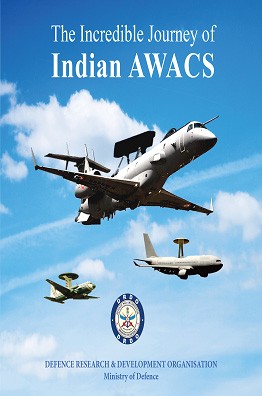Book Review
The Incredible journey of Indian AWACS K Ramchand, S Krishnasamy, B R Srikanth DESIDOC (2019)

In the aftermath of the 1971 India-Pakistan war, India started developing its Airborne Early Warning and Control System (AEW&C). The then chief of India’s Defence Research and Development Organisation (DRDO) V. S. Arunachalam rightly envisaged that since no country was willing to share the knowhow for such sensitive technology, making it from scratch in India was the only solution. Twenty years later, DRDO had set up a dedicated laboratory – the Centre for Airborne Systems (CABS) – in Bangalore with K. Ramchand as its director.
That dream of putting an eye in the sky for the Indian Air Force (IAF) eventually came true when a state-of-the-art airborne warning and control system was deployed as a flagship of the country’s defence programme. The IAF has inducted two of these systems now. One, in fact, provided precision control to India’s combat jets during the much talked about surgical strike on a terrorist camp in Balakot, Pakistan in February 2019.
Scientists Ramchand and S. Krishnaswamy – both of whom played key roles in the project – have teamed up with defence journalist B. R. Srikanth to narrate this three-decade journey of DRDO’s ‘jewel in the crown’, the AEW&C, a forerunner to an advanced airborne warning and control system (AWACS). The Incredible journey of Indian AWACS chronicles, through personal anecdotes, the scientific and engineering feats that went into creating India’s airborne surveillance programme.
The first leg of this two-decade-long journey, however, was catastrophic. The Hindustan Aeronautics Limited (HAL) conducted an airborne surveillance project codenamed ‘Airavat’ using a modified HS748 aircraft as the flying test bed. Airavat had indigenously developed systems including a ‘rotodome’ that housed the all-important radar. It flew several sorties and was demonstrated at India’s air shows in 1996 and 1998. But disaster struck in January 1999, when the aircraft crashed during a flight trial near Chennai, killing all eight passengers – four scientists and four IAF officers.
Deeply saddened by the tragedy, the DRDO head A.P.J. Abdul Kalam had said, "The young men laid down their precious lives in pursuit of national scientific goals. We shall honour them by carrying on their unfinished work."
The monograph details the relaunch of the programme in 2004 helmed by S. Christopher. The objective was clear – to design and develop an airborne surveillance system indigenously, and to mount it on an aircraft procured from abroad. The EMB-145 aircraft, manufactured by Brazilian company M/s Embraer, was chosen for this purpose. M/s Embraer were contracted to deliver three aircraft. However, there was a challenge – the aircraft had to be fitted with DRDO-supplied hardware systems for the surveillance mission, test flown and certified before delivery.
The authors describe how this interesting formula worked out. About 300 systems (including a dummy antenna array) were produced in DRDO work centres and sent to the Brazilian company. These were fitted into the aircraft during their manufacture. The first of the three modified EMB-145 aircraft arrived in India on 22 August 2012, with the second following in 2013.
The programme team began transforming the Brazilian-platform aircraft to a full-fledged airborne surveillance plane. They installed the indigenous AEW&C and other mission systems on to the aircraft and carried out more than 1000 hours of flight trials over mountains, jungles, deserts, seas and plains.
After the IAF was satisfied with the "simulated exercises", it formally inducted the surveillance aircraft into service on February 14, 2017, which the authors describe as "a red letter day in DRDO's history".
Former Defence Minister Manohar Parrikar called them India's Netra (eyes in Sanskrit) – a force-multiplier with high end surveillance capabilities fitted into a sleek frame. The system can detect and track multiple airborne intruders simultaneously, identify if they are friend or foe, and initiate appropriate air- or ground-based counter-measures. It incorporates both line-of-sight and satellite links, can intercept hostile communications and, detect and capture radar emissions from the ground or air. Equipped with an in-flight refuelling system, it can get airborne from any military airfield in the country.
The system got global display at the Bahrain International Airshow 2014, the Aero India 2015 and during the Republic Day flypast in 2017. Christopher says in the monograph that the AEW&C is a "good example of the Make-in- India movement" and has immense export potential.
Enhanced versions of the AEW&C for the Indian Navy and Army are already in the works.
The current head of DRDO Satheesh Reddy says The Incredible journey of Indian AWACS is a tribute to all officials associated with the development of the AEW&C and will inspire the next generation of defence scientists.
